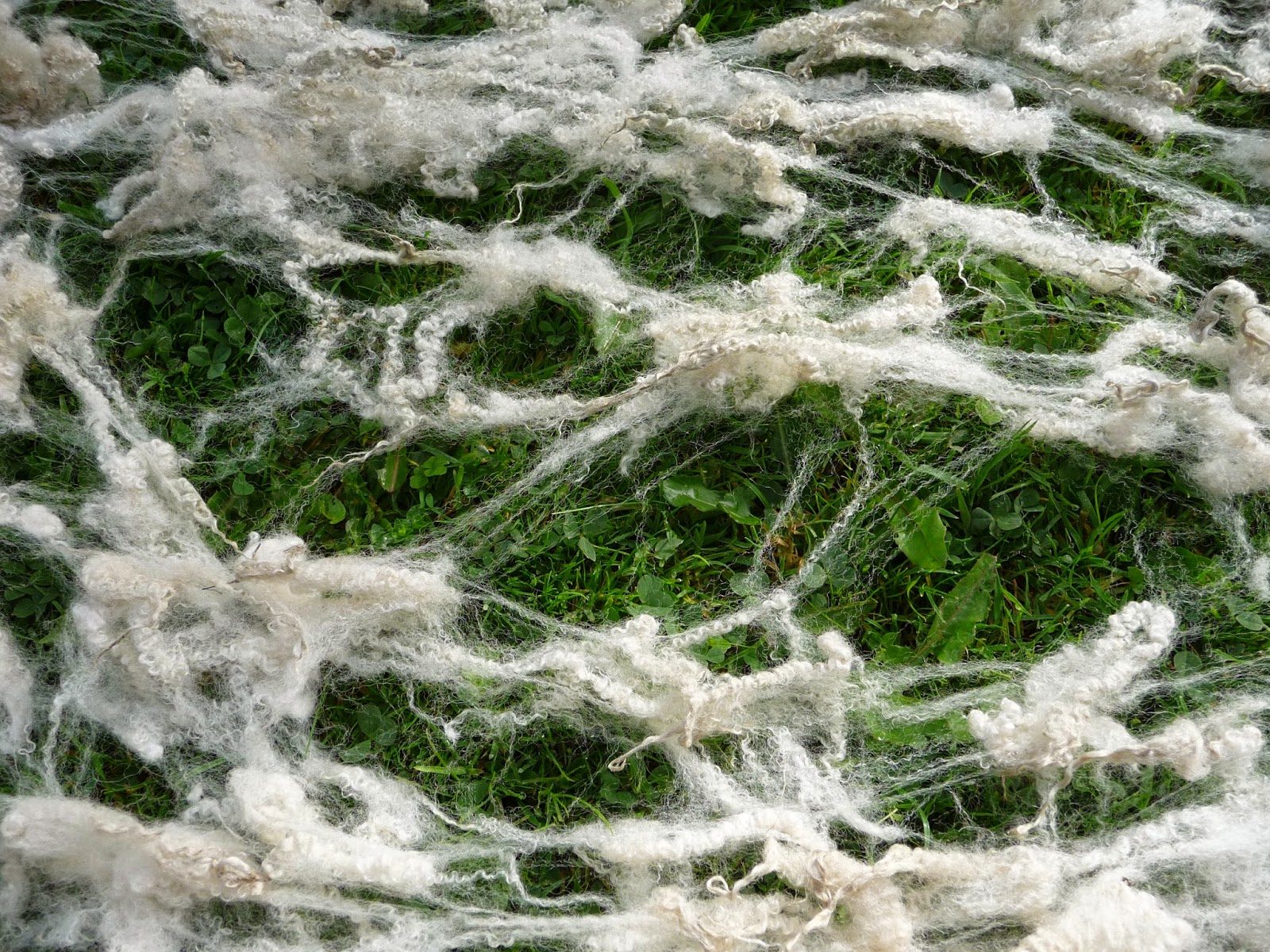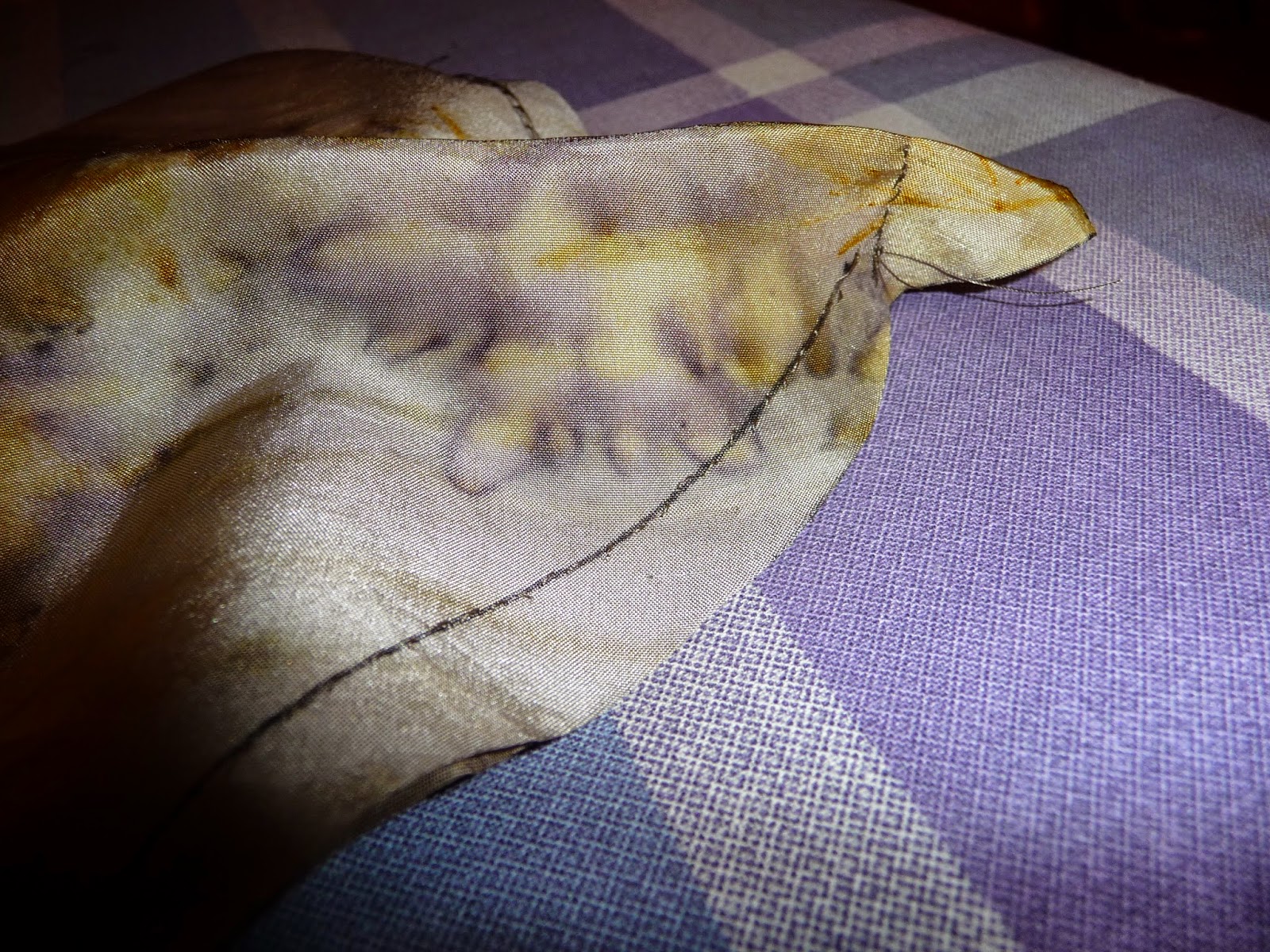The sufferings of this Mule fleece have been considerable. Here is how it began, as a very pleasing £10 purchase. Well skirted - all matted crap pulled off the edges. Open - see how the grass shows through 'windows', because the blanket, or underside is not felted together. Pretty clean - hardly any tangled vegetable matter.
Oh yes, I can pick a good fleece these days. To be truthful, I bought it from an expert spinner who really does know what she is doing. In close up, these fibres have a staple length of 10-15cm, are white, fine and lustrous with a medium crimp tending to ringlets at the tip and a moderate amount of lanolin. Rather a dream to work with and something I was looking forward to.
Blue Faced Leicester (BFL) is a longwool highly esteemed by the cognoscenti. They speak it having 'a good handle' due to fine, soft fibres and manageable staple length, but mutter darkly of the endless hassle of combing out its ringlets before spinning. This is not a rare breed in the UK and commercially prepared tops or roving are easy to come by. My enthusiasm for starting from the raw product persists, despite setbacks, so a Mule fleece ought to be just the ticket for me to work with.
All the offspring of BFL sires are called mules, though their mothers could be any kind of hardy ewe. This fleece resulted from a cross between a BFL ram and a Swaledale ewe, so the sheep who grew it was called a North of England Mule. All very confusing, having sheep called mules. Such was my ignorance, I had half an idea mule fleeces might come from a small, fluffy horse. On Lambing Live last spring, they did a short piece about sheep breeding, which explained some of the complexities of farming to produce lamb to eat. The paternal BFL influence gives mules reliable fertility and plenty of milk - ideal qualities for them to produce the final generation, which is a crop of lambs for market. The fact that BFL genes also improve the mules' wool is a complete bonus for spinners, as shearing is just a time consuming and expensive part of keeping sheep, from the meat farmers' point of view. The Swaledale is an old established breed from the Black Faced Mountain family, habituated to withstanding cold, wet winters in the hills of the Lake District. Accordingly, its fleece is rougher and contains kemp fibres. Typically, the Mule fleece will be coarser than pure BFL, the trade off being less tightly curled ringlets, making it easier for a hand spinner like me to prepare.
 This is a wool that likes to felt and is not heavy with grease, so I thought a long soak in my suint vat would get the dirt and enough of the lanolin off without agitating the fibres and matting the whole thing up. I could have been right, only I left it too long and forgot to put the dark cover over my clear plastic vat. Oh disaster. The whole lot went dark green and dripping with algae. I had to trudge around the garden doling out smelly pea soup suint water
This is a wool that likes to felt and is not heavy with grease, so I thought a long soak in my suint vat would get the dirt and enough of the lanolin off without agitating the fibres and matting the whole thing up. I could have been right, only I left it too long and forgot to put the dark cover over my clear plastic vat. Oh disaster. The whole lot went dark green and dripping with algae. I had to trudge around the garden doling out smelly pea soup suint water onto the borders from a watering can, then scrub out the tub before starting it again from scratch. The pictures show the new suint vat starting to soak another fleece from a local farm. This was from a North of England Mule crossed with a Suffolk. An example of third generation breeding, this fleece is another degree coarser and less crimpy than BFL. I'll use it to make something hardwearing like a rug or a bag. I suppose the sheep was a meat lamb that did not go for slaughter, though I am not sure I have the nerve to ask Gwyn why he kept it. Properly covered, I have had no trouble with algae in the vat since then.
Meanwhile, the gloopy green North of England Mule fleece had had several all day rinses and drains in my second big container and lay neglected in the sun on the rack in the greenhouse, steaming, then parching out to a dry shadow of its former glory. Some of it was too algae stained, only good for compost, but a big pile looked worth washing properly with hot water and detergent.
"Still messing about with that poor mule fleece? You could write Four Quartets about the time you've spent on this. At least a verse of East Coker - So here you are, in the middle way, lot of hours largely wasted, trying to clean fleece."
"Every attempt is a wholly new start, Elinor."
"A different kind of failure, Beaut. Here, there is only the fight to recover what has been lost."
"Conditions do seem unpropitious. I think I am going to dye it in the wool, hoping the last of this dirt will fall out when I flick the locks to spin."
By the end of August, the Japanese indigo plants in the greenhouse had bushed out thickly after the July harvest. I particularly admire the blue/green colour the leaves give using the vinegar method. I cut back all six plants again. Even after the stalks were discarded, there was over 500g of leaves to go through the blender. This could be a winner, vinegar to soften the fibres and dyeing to camouflage the greyish cast left on the locks by the algae.
Although the dye strength with vinegar is low and the fleece weighed over a kilogram, divided into portions, it all went through at least an hour soak to get the benefit of the vinegar and pick up whatever colour sucessive dye baths had to offer.
 Variations on a marine theme - lovely. I used a dog brush to open up the locks and cheerfully spun a fine single from randomly selected tufts of Mule fleece. Each venture may be a new beginning, but this method took an age to fill a bobbin and I wanted to see how the wool would turn out.
Variations on a marine theme - lovely. I used a dog brush to open up the locks and cheerfully spun a fine single from randomly selected tufts of Mule fleece. Each venture may be a new beginning, but this method took an age to fill a bobbin and I wanted to see how the wool would turn out.Hurriedly Navajo three plied and washed, the yarn is shabby, a general mess of imprecision at each stage of its execution. Elinor observed that it falls short of T S Eliot's vision of the wave cry, the wind cry or the vast waters of the petrel and the porpoise. Then she relented. "Chwarae teg, Beaut. In the words of the man himself 'For us there is only the trying. The rest is not our business.'"













































